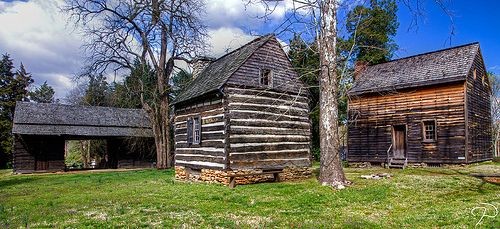Tannenbaum Historic Park
Introduction
Text-to-speech Audio
Images
Tannenbaum Historic Park offers a recreation of the Hoskins Farm where General Greene's American militia battled against General Cornwallis and the British troops.

Backstory and Context
Text-to-speech Audio
Joseph
and Sarah Hoskins lived near Valley Forge in Pennsylvania when the American
Revolution erupted. Like many other families, they had been devastated by the
war. In order to escape the difficulties brought on by the war, they moved to
the Piedmont region of North Carolina in 1778. Their home was located near
Guilford Courthouse. From their arrival in North Carolina in 1778 to 1781, the
Hoskins’ labored to open fields, plant and harvest crops, and do everything in their
power to start a new life for themselves. By 1781 they managed to put together
a farm of 150-acres. Unfortunately, that same year the war had reached their
doorsteps once again.
American and British armies swept through the area in February 1781 during a
period referred to “Race to the Dan”. Nathaniel Greene won the race and was
able to move his army across the Dan River before General Cornwallis could
catch them. Not long after, the Battle of Guilford Courthouse followed. The
farm suffered damage during the battle. Fortunately, the family survived and
remained on the land for several more years.
On March 15, 1781, having learned that his American counterpart General Nathaniel Greene had formed his army at Guilford Courthouse, Cornwallis advanced up the Great Salisbury Wagon Road (today's New Garden Road) to meet him. As he reached the 150-acre Hoskins Farm, the British general's lead troops discovered the first American line of battle formed behind a rail fence with two pieces of cannon aimed directly down the road.
After finding out General Nathaniel Greene had formed his army at Guilford Courthouse, on March 15, 1781, General Cornwallis moved along the Great Salisbury Wagon Road (now New Garden Road) to meet Greene. Upon arriving at the Hoskins 150-acre farm, the British troops found the first American line of battle formed behind a rail fence. The American troops aiming two pieces of cannon directly down the road towards the British Troops. Cornwallis proceeded to move his 1,800 men onto the grounds and fields of the farm.
The British troops formed their lines and
deployed their own cannon. They were preparing for the approaching fight. A
cannonade took place for 30 minutes. The British troops began advancing toward
the American militia ahead of them. This began the Battle of Guilford
Courthouse which became a key battle in the American Revolution. Greene led the
American troops to cause great devastation to the British troops before
retreating from the field in good order.
Although Cornwallis secured a tactical victory on the ground at Hoskins Farm,
he had to fall back to the coast of Wilmington to obtain more supplies and
regroup. In the fall he was trapped at Yorktown and forced to surrender. It was
the battle that took place on the Hoskins Farm that set these events into
motion.
